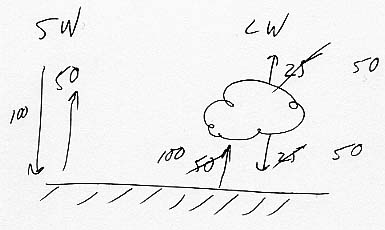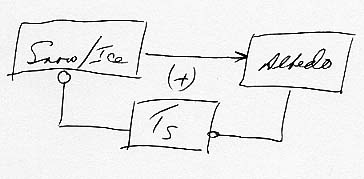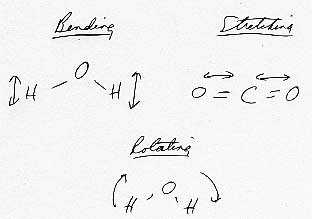
OCG123, Spring 2002
First hourly exam, Monday 11 February
Chapters 1–3
Definitions (2 points each; 20
points total)
1. Global warming—Anthropogenic
additions to the greenhouse effect.
2. Greenhouse gases—CO2,
CH4, H2O, etc. that warm the surface by absorbing and
reradiating upward-bound IR radiation back toward the surface.
3. Biodiversity—The variety of life
forms, usually referred to a particular part of the earth.
4. Positive feedback loop—A loop with
an even number of negative couplings (including zero). It tends to amplify the
effects of disturbances.
5. Unstable equilibrium—A state where
the system will remain if undisturbed, but where even a slight disturbance will
move it to another equilibrium state.
6. Perturbation—A temporary
disturbance of a system.
7. Short-wave radiation—Solar
radiation (in the visible range).
8. Troposphere—The lowermost layer in
the earth’s atmosphere, to which the weather is confined and where the
temperature decreases rapidly with altitude.
9. Inverse-square law—The law that
states that a property such as solar radiation decreases as the inverse square
of the distance from an object such as the sun.
10. Blackbody—A perfect radiator and
absorber; absorbs and radiates equally well at all wavelengths.
Short answers (3 points each; 30
points total)
1. Name the four components of the earth
system. Atmosphere, hydrosphere, solid earth, biota.
2. What is the most important greenhouse
gas on earth (has the biggest effect)? Water vapor.
3. Explain the “faint young Sun
paradox.” Even though the sun was about 30% fainter when the earth was
young, the earth was not correspondingly cooler then.
4. What is the Gaia hypothesis? The
earth is a self-regulating system in which the biota play an integral role.
5. How has atmospheric CO2
varied since 1800? Use a diagram if you wish. It began to rise slowly in the
early 1800s as American settlers cleared forest for agriculture (the pioneer
effect). It then rose a little faster after about 1850 (the industrial age), and
accelerated around 1950. Regular annual cycles are superimposed on these
longer-term trends.
6. What is the main function of the
daisies in Daisyworld? To reflect sunlight (by increasing the earth’s
albedo) and stabilize the climate (keep it cooler than otherwise).
7. Do forests on earth affect our climate
in the way that daisies affect Daisyworld? Why or why not? No, because
forests are not markedly brighter than exposed ground.
8. Given that stars become increasingly
luminous with time, what is the ultimate fate of Daisyworld, and why? All the
daisies will eventually die because they can protect against only a certain
amount of solar brightening. Daisyworld will sooner or later become too hot for
them.
9. What is the difference between visible
and infrared radiation? The wavelengths of visible radiation are 0.4–0.7 µm,
whereas those for IR are 1–1000 µm. We can see visible radiation but not IR.
10. What is the main wavelength at which
your body radiates, and why? A rough numerical value is good enough. We
radiate at about 10 µm (in the IR), like the earth, because our temperature is
about the same as the earth’s.
Problems and longer answers (10
points each; 50 points total)
1. Describe in as much detail as you can a
typical ice-age cycle as revealed by the Vostok ice core. Use a diagram. A
typical cycle lasts for 100,000–120,000 years, with about 80% being in the
cold glacial phase and 20% in the warmer interglacial phase. The glacial is
about 6şC–8şC colder than the interglacial. The cycle is shaped like an
asymmetric sawtooth, with a rapid rise into the interglacial and a slower
descent into the glacial. There are brief periods of intermediate warming during
the glacial phase.
2. Planet X receives a flux of 100 units of solar radiation and has an albedo of 50%. Its atmosphere is like Earth’s. Draw a diagram showing how its greenhouse effect works. The earth receives 100 units of SW radiation and reflects 50 back to space. The other 50 are absorbed, mostly at the surface. They are reradiated as LW and intercepted by the greenhouse gases, which radiate 25 back to the surface and 25 to space. In order to balance the SW and LW sides, i.e., to get 50 LW back to space, the LW side must be doubled to 100 radiated from the surface and 50 up and down from the atmosphere.

3. Planet Y has a solar constant S = 2000 W m-2 at the edge of its atmosphere and an albedo of 20%. Given the Stefan-Boltzmann constant of s = 5.67 x 10-8 W m-2 K-4, calculate the equilibrium temperature of its surface in the absence of a greenhouse effect. If you are unsure of the formula to use, derive it.
Ty = [S(1 – A)/4s]0.25 = [2000(0.8)/4(5.67 x 10-8)]0.25 = 290K
4. Draw and explain the system diagram for surface temperature (Ts), the amount of snow and ice cover (Snow and ice cover), and the surface albedo (Albedo). Is the feedback loop positive or negative, and why? The loop is positive because it contains two negative couplings.

5. Explain the molecular mechanisms by which the major greenhouse gases absorb and reradiate outgoing terrestrial radiation. Use diagrams if necessary. The greenhouse gases absorb outgoing IR radiation because the frequencies of their bending, stretching, and rotating are similar to those of IR radiation (sympathetic to them). After they absorb the radiation, they eventually release it (reradiate it), but isotropically because all directions are the same to them.
